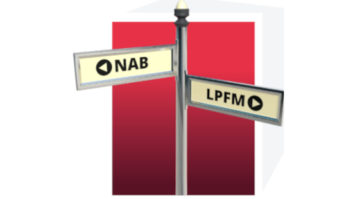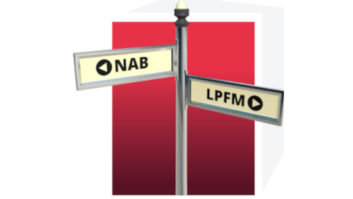 The author is with WHYU(LP), licensed to the American Militia Association, in Meyersdale, Pa.
The author is with WHYU(LP), licensed to the American Militia Association, in Meyersdale, Pa.
Regarding the stories “LP-250 FM Petition Draws Lots of Interest” and “NAB Renews Objections to LP-250.”
The NAB has a single goal: looking out for the financial interests of incumbent, commercial, full-power stations.
It is well-known that many struggling LPFM stations are not only facing financial burdens keeping their stations on the air, but also to be heard by the people in the communities they serve.
In most rural areas, LPFM signals at 100 Watts ERP at 30m HAAT are simply not strong enough to overcome terrain and spacing of homes to be adequately tuned in for reliable listening. While this may be quite different for flat terrain metro areas, that is not the norm for the majority of LPFM stations.
The NAB and its members are quite pleased that LPFMs thus far have not had any significant negative impact on the number of listeners they receive for their full-power stations. They know that the LPFM signals are not strong enough or large enough to cause their listeners to seek out noncommercial local alternatives to their ad-bloated and nationally mirrored nonlocal content.
How do they wish to sway the FCC against any expansion in service for LPFMs? They allege that LPFMs do not and will not comply with FCC regulations.
This is just another ruse, as many LPFMs have been fined for breaking the rules, and when an LPFM causes actual interference, full-power stations retain their protected status and can force LPFMs off the air.
What they want is even greater protection and monopoly of the dial and to snuff out what they know is a potential problem for them — a potential reduction in listeners and advertiser dollars that have the tiniest potential of being redirected to LPFM underwriting.
The NAB has rejected every LPFM-related proposal for this reason alone. The opposition comments attempt to vilify all LPFMs as rule-breakers and toss out technical jargon to somehow convince regulators that an LPFM being able to be heard by their communities will flood the airwaves with interference.
The truth is that the NAB thinks it is unfair that a nonprofit station doesn’t pay as much as they do for listener acquisition, although full-power commercial stations can pay their fees without nearly as much financial concern as the low-power, weak-signaled LPFM station that can hardly be heard by any significant audience.
Two hundred and fifty watts is not anywhere close to the average full power of such stations, and to suggest otherwise is ridiculous.
Congress passed legislation authorizing such local community stations, surely with an intent that they could be heard by the communities they serve. Increasing that ability while continuing to limit interference and protecting the very stations the NAB supports would meet the needs of the legislative mandate.
The FCC should consider the NAB objections for what they are: nonsensical bias to further protect their financial interests.
RW welcomes comments on this or any article. Email [email protected] with “Letter to the Editor” in the subject field.
The post Commentary: Skip the Nonsensical Bias About LPFM appeared first on Radio World.

